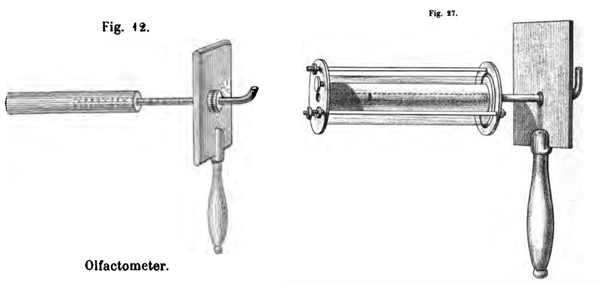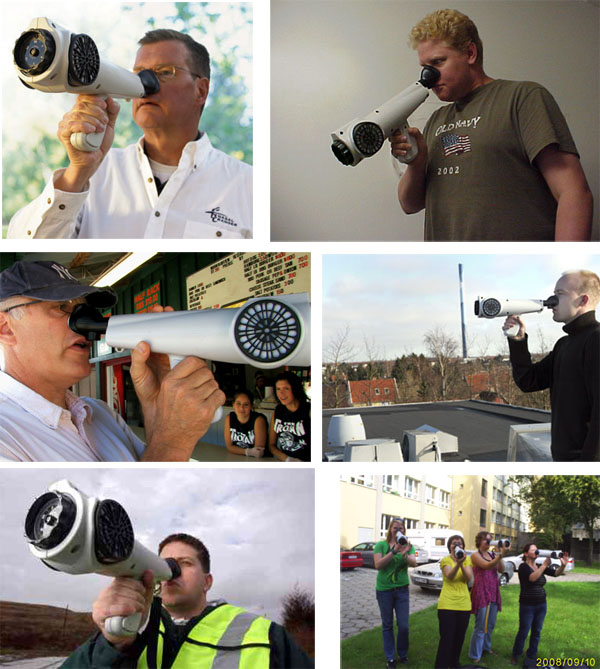Smell and evocative instrumentation
January 9th, 2012Tags: augmented, nasal ranger, nose, odor, odorants, odour, olfactometer, Rousseau, sense, smell, Zwaardemaker
I have been conducting a literature review of sensitivity and selectivity in olfaction– in machine olfaction and animal olfaction. Although the review itself is rather dry, some of the (humorous) detours that didn’t make it in the review are documented here.
In 1762, Rousseau wrote in Émile, or On Education, that smell was the sense of the imagination; as it gives tone to the nerves it must have great effect on the brain. Little did Rousseau know that the olfactory nerve was the only cranial nerve besides the optic nerve that does not route through the brainstem.
He continues: Smells by themselves are weak sensations. They move the imagination more than the sense and effect us not so much by fulfilment as by expectation. Smell as a cue to a memory, which may draw whimsical or visceral responses.
An extremely sensitive reflex may result from these memories, at least in rats: apparently they can smell down to 0.04 ppt of 2,4,5-trimethylthiazoline, which happens to be an odorant exuded from the anal glands of cats and red foxes (Laska et al. 2005). Analytical instrumentation pales in comparison, only managing to detect odorants at ppb levels at best (with ideal sample presentation, slow analysis, and no masking odorants present).
Even now, smell experiments (e.g. for determining permissible odour levels around landfills) are often conducted with panels of experts instead of with instrumentation alone. (In fact, some legislation around smell is based on number of complaints reported, because detecting the smell levels directly is deemed too complicated/expensive.) TSA dogs are sniffing your bags for bombs or apples. But to be able to measure things like how long it takes to detect the smell or where the smell is stronger, people have been inventing funny machines at least since the early 19th century.
In 1895, Henrik Zwaardemaker, professor at Utrecht University, published Physiologie des Geruchs, a treatise on olfaction and odorants. In it, he details different methods of presenting odorants to subjects in a controlled fashion:

Zwaardemaker’s olfactometers, or Riechmesser. The second is an improvement upon the first, with an interchangable odorant chamber. From Physiologie des Geruchs.

A set up for measuring time taken to detect a smell? Not sure where the big pointy thing goes to… From Physiologie des Geruchs.
But the most funny man-chine is preserved for the present day! Might I share the NASAL RANGER™:

Look at how SCIENTIFIC these people look! They must be so AUGMENTED! These images are all lifted from a google image search for Nasal Ranger.
The Nasal Ranger™ does nothing more than provide some ratio of active carbon filtered and non-filtered air. So you can just smell the air, or just smell nothing, or something in between. You can decide if there is a big difference between filtered and not-filtered air. It’s not that fancy. Yet it evokes TECHNONOSE, or BETTER-THAN-YOURS nose. Here they even describe it as a “mobile artificial nose”, even though the nose part actually belongs to the person holding the retrofuturistic contraption (which apparently costs 1500 USD).
Another silly instrument, another day. Next thing you know, they’ll be measuring odorant levels in Degrees Brix.
addendum
Marco points out that the Nasal Ranger looks surprisingly similar to something already invented by Professor Farnsworth:

The SMELL-O-SCOPE! “The Smell-O-Scope allows the user to smell odours over astronomically long distances (”If a dog craps anywhere in the universe, you can bet I won’t be out of the loop”). The degree of odour can be measured on a meter called the “Funkometer”. It is unknown how the device functions, but it apparently has a lens and a stench coil.”
addendum ii
I wanted to include this excerpt too, to point out what a funny guy Dhr. Zwaardemaker was:

Teehee, Fäcalgestank.
